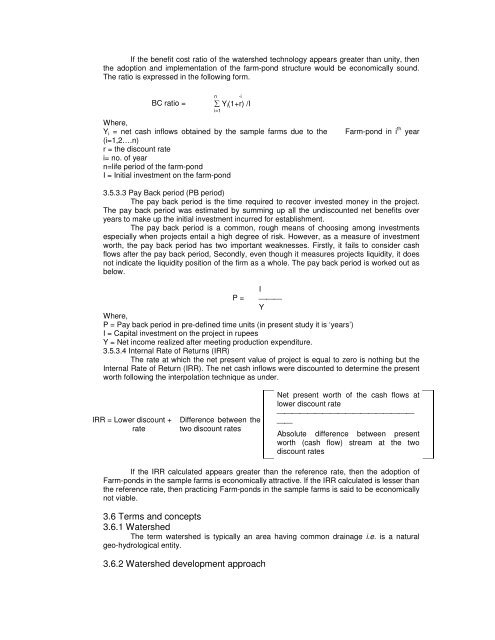Master of Science - ETD | Electronic Theses and Dissertations of ...
Master of Science - ETD | Electronic Theses and Dissertations of ...
Master of Science - ETD | Electronic Theses and Dissertations of ...
Create successful ePaper yourself
Turn your PDF publications into a flip-book with our unique Google optimized e-Paper software.
If the benefit cost ratio <strong>of</strong> the watershed technology appears greater than unity, then<br />
the adoption <strong>and</strong> implementation <strong>of</strong> the farm-pond structure would be economically sound.<br />
The ratio is expressed in the following form.<br />
n -i<br />
BC ratio = ∑ Yi(1+r) /I<br />
i=1<br />
Where,<br />
Y i = net cash inflows obtained by the sample farms due to the Farm-pond in i th year<br />
(i=1,2….n)<br />
r = the discount rate<br />
i= no. <strong>of</strong> year<br />
n=life period <strong>of</strong> the farm-pond<br />
I = Initial investment on the farm-pond<br />
3.5.3.3 Pay Back period (PB period)<br />
The pay back period is the time required to recover invested money in the project.<br />
The pay back period was estimated by summing up all the undiscounted net benefits over<br />
years to make up the initial investment incurred for establishment.<br />
The pay back period is a common, rough means <strong>of</strong> choosing among investments<br />
especially when projects entail a high degree <strong>of</strong> risk. However, as a measure <strong>of</strong> investment<br />
worth, the pay back period has two important weaknesses. Firstly, it fails to consider cash<br />
flows after the pay back period, Secondly, even though it measures projects liquidity, it does<br />
not indicate the liquidity position <strong>of</strong> the firm as a whole. The pay back period is worked out as<br />
below.<br />
I<br />
P = ⎯⎯⎯<br />
Y<br />
Where,<br />
P = Pay back period in pre-defined time units (in present study it is ‘years’)<br />
I = Capital investment on the project in rupees<br />
Y = Net income realized after meeting production expenditure.<br />
3.5.3.4 Internal Rate <strong>of</strong> Returns (IRR)<br />
The rate at which the net present value <strong>of</strong> project is equal to zero is nothing but the<br />
Internal Rate <strong>of</strong> Return (IRR). The net cash inflows were discounted to determine the present<br />
worth following the interpolation technique as under.<br />
IRR = Lower discount +<br />
rate<br />
Net present worth <strong>of</strong> the cash flows at<br />
lower discount rate<br />
⎯⎯⎯⎯⎯⎯⎯⎯⎯⎯⎯⎯⎯⎯⎯⎯⎯⎯<br />
Difference between the ⎯⎯<br />
two discount rates<br />
Absolute difference between present<br />
worth (cash flow) stream at the two<br />
discount rates<br />
If the IRR calculated appears greater than the reference rate, then the adoption <strong>of</strong><br />
Farm-ponds in the sample farms is economically attractive. If the IRR calculated is lesser than<br />
the reference rate, then practicing Farm-ponds in the sample farms is said to be economically<br />
not viable.<br />
3.6 Terms <strong>and</strong> concepts<br />
3.6.1 Watershed<br />
The term watershed is typically an area having common drainage i.e. is a natural<br />
geo-hydrological entity.<br />
3.6.2 Watershed development approach
















